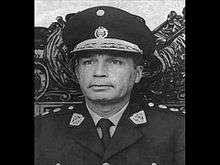Francisco Morales Bermúdez
| Francisco Morales-Bermúdez Cerruti | |
|---|---|
 | |
| President of Peru Armed Forces Revolutionary Government | |
|
In office 30 August 1975 – 28 July 1980 | |
| Prime Minister |
Oscar Vargas Prieto Jorge Fernández-Maldonado Guillermo Arbulú Galliani Óscar Molina Pallochia Pedro Richter Prada |
| Vice President | Pedro Ritcher Prada |
| Preceded by |
Juan Velasco Alvarado (President of the Armed Forces Revolutionary Government) |
| Succeeded by |
Fernando Belaúnde (Constitutional President) |
| Prime Minister of Peru | |
|
In office 1 February 1975 – 30 August 1975 | |
| President | Juan Velasco Alvarado |
| Preceded by | Luis Edgardo Mercado Jarrín |
| Succeeded by | Oscar Vargas Prieto |
| Minister of War | |
|
In office 1 February 1975 – 30 August 1975 | |
| President | Juan Velasco Alvarado |
| Preceded by | Luis Edgardo Mercado Jarrín |
| Succeeded by | Oscar Vargas Prieto |
| Minister of Economy and Finance | |
|
In office 13 June 1969 – 2 January 1974 | |
| President | Juan Velasco Alvarado |
| Preceded by | Ángel Valdivia Morriberon (Minister of Finance and Commerce) |
| Succeeded by | Guillermo Marcó del Pont |
| Personal details | |
| Born |
October 4, 1921 Lima, Peru |
| Nationality | Peruvian |
| Profession | Army General |
Francisco Morales Bermúdez Cerruti (born October 4, 1921) is a Peruvian general who came to power in Peru in 1975 after deposing his predecessor, General Juan Velasco.[1][2] His grandfather and all his original family were from the old Peruvian department of Tarapacá, which is now part of the Chilean territory. Unable to control the political and economic troubles that the nation faced, he was forced to return power to civilian rule, marking the end of the Revolutionary Government of the Armed Forces, installed by a coup d'etat on October 3, 1968.
Early years
Born in Lima in 1921, he is the son of Army Colonel Remigio Morales Bermúdez and grandson of ex-President Remigio Morales Bermúdez. He received most of his education at Lima's Colegio Inmaculada. In 1939, he was accepted to the Escuela Militar de Chorrillos (Chorrillos Military School). After his graduation, he was an important member of the Centro de Altos Estudios Militares (CAEM).
Political career
Bermúdez achieved the rank of Brigadier General and was appointed to his first political post in 1968 as minister of finance in the administration of Fernando Belaúnde. Internal problems in government forced him to resign after two months.
In 1968, after Belaúnde had been deposed by a coup, the military government led by Velasco asked him to return to the post of Minister of Finance. In 1974, he resigned again, this time because he was appointed Commander-in-Chief of the Peruvian Army. In 1975, he was appointed to be both Prime Minister and Minister of War.
With Velasco's health deteriorating, Morales Bermúdez led a military junta against General Velasco and took over as President of Peru on August 29, 1975, leading the country through one of its most severe economic crises. He diverged from the socialist-leaning tendencies of first phase (1968–1975) of the Peruvian Revolution, proclaiming a 'Second Phase' that would lead to a return to democracy.
Legacy
The failure of his political and economic reforms was a severe blow to his administration, hampered by constant political pressure from all sides. A Constitutional Assembly was created in 1978, which replaced the 1933 Constitution enacted during Óscar R. Benavides's presidency; he also called for national elections the next year.
After the 1980 National Elections he turned power over to a legally established government, headed by President Fernando Belaúnde.
After he has presidency, he kept a relatively low profile in Peruvian politics, making sporadic speeches regarding the situation of the army.
In 1985, he made an unsuccessful run for the presidency, obtaining a fraction of one percent of the vote.
Morales Bermudez is currently being prosecuted by Italian judge Luisianna Figliolia for the presumed forced disappearance of 25 Italian citizens in the frame of Operation Condor, a campaign of political oppression against leftists orchestrated by the right-wing dictatorships of South America in the 1970s.[3]
References
| Political offices | ||
|---|---|---|
| Preceded by Edgardo Mercado Jarrín |
Prime Minister of Peru February 1, 1975 – August 30, 1975 |
Succeeded by Óscar Vargas Prieto |
| Preceded by Juan Velasco |
President of the Revolutionary Government August 1975 – July 1980 |
Succeeded by Fernando Belaúnde |
| Military offices | ||
| Preceded by Gral. Edgardo Mercado Jarrín |
Commander-in-Chief of the Army February 1, 1975 – August 30, 1975 |
Succeeded by Gral. Óscar Vargas Prieto |
